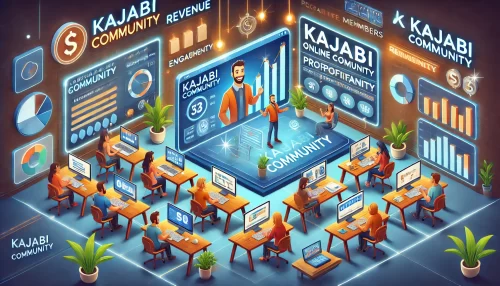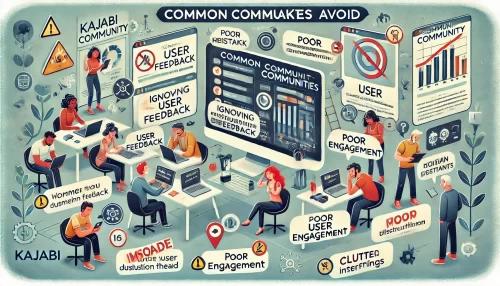Table of Contents
Are you wondering how Kajabi communities could be the game-changer for your business? What if you could create a space that not only connects your audience but also becomes a revenue-generating powerhouse?
In this article, we’ll dive into the proven ways Kajabi communities can help you grow your income quickly and sustainably. Whether you’re a course creator, coach, or content entrepreneur, you’ll discover actionable strategies to unlock the full potential of this platform. Ready to build a community that pays off? Let’s get started!
Understanding Kajabi Communities and Their Revenue Potential

Kajabi communities aren’t just another social platform—they’re powerful ecosystems designed to nurture loyal followers and generate sustainable income streams. In this section, you’ll uncover what makes them unique and why they have immense revenue-boosting potential.
What Are Kajabi Communities and How Do They Work?
Kajabi communities are digital spaces within the Kajabi platform that allow creators, entrepreneurs, and businesses to connect with their audience in a highly interactive way. Unlike traditional forums or social groups, these communities are designed with business growth in mind, offering features that promote learning, engagement, and monetization.
Think of it like this: instead of managing a scattered audience across multiple platforms, you centralize everything in one location. Here, members can access courses, discussions, coaching sessions, and exclusive content under a single roof. This structure makes it easy to create value, build trust, and drive purchases seamlessly.
From what I’ve seen, many entrepreneurs thrive when they use Kajabi communities to cultivate stronger relationships. It’s more than just conversations—every interaction can be tied back to a specific business goal. For instance, community discussions often generate ideas for new products or services, creating a cycle of continuous revenue generation.
Key benefits of Kajabi communities include:
- Exclusive access to premium content.
- Direct interaction with members through chats, posts, and live sessions.
- The ability to integrate product offers directly into discussions.
This isn’t just about building a following; it’s about fostering a community that continuously feeds into your business model.
Key Features of Kajabi Communities That Drive Engagement
When it comes to generating revenue, engagement is the heartbeat of success. Kajabi communities are built with features that make interacting with your audience effortless and meaningful, creating an environment where members keep coming back.
- Discussion Boards and Forums: Members can easily start conversations, ask questions, and share their experiences, creating a collaborative space. This leads to greater retention, which directly impacts recurring revenue.
- Live Events and Webinars: Hosting live Q&As, workshops, or exclusive training sessions keeps your community active and interested. Live events are perfect opportunities to promote products or courses that solve real-time problems.
- Integrated Course Access: Members don’t need to leave the community to access educational content. This seamless integration makes it easier to upsell them on related products or higher-tier courses.
- Gamification and Incentives: You can offer rewards for milestones, like completing courses or participating in discussions. These incentives help sustain long-term engagement, which is crucial for consistent revenue growth.
- Push Notifications and Reminders: Keeping members informed about new content or offers helps drive participation, reducing the chances of inactive members.
In my experience, the more interactive you make your community, the more likely your audience will convert into loyal customers. A highly engaged community isn’t just a bonus—it’s the secret to fast, sustainable revenue growth.
Why Engaged Communities Lead to Faster Revenue Growth
Let me break it down for you: engagement drives trust, trust drives purchases, and consistent purchases create scalable revenue. Kajabi communities excel at nurturing this cycle by keeping your audience active, invested, and willing to buy.
Here’s why engagement matters so much:
- High Engagement Equals Higher Retention: When members feel part of an active, valuable community, they’re more likely to stay subscribed or renew memberships. That retention means consistent, recurring revenue.
- Direct Feedback on Products and Services: Your community is your sounding board. If you’re launching a new course or product, engaged members provide instant feedback, helping you fine-tune your offering and boost sales.
- Upselling Opportunities: Engaged members often explore more of your content. Whether it’s upgrading to a premium membership or purchasing add-ons, active participants are easier to convert.
- Word-of-Mouth Marketing: An engaged community doesn’t just help you retain current members—it also attracts new ones. Members naturally share their experiences, which can lead to organic growth and new revenue streams.
For many of us, the goal isn’t just one-time sales—it’s creating an ecosystem where members continuously engage and contribute to your success. With Kajabi communities, that’s not a distant dream—it’s a reality you can achieve with the right strategy.
Pro Tip: To keep your community active, don’t just focus on promoting your products. Instead, provide continuous value through conversations, lessons, and challenges. As engagement grows, you’ll see revenue growth naturally follow.
Setting Up a Kajabi Community for Profitability

Creating a profitable Kajabi community starts with careful planning. To maximize earnings, you’ll need to focus on identifying the right audience, structuring the community effectively, and integrating revenue-focused strategies. Let’s break down the key components to help you get started.
Choosing the Right Niche for Your Community
Picking the right niche for your Kajabi community is where profitability begins. The more specific and targeted your niche, the easier it is to attract engaged members and convert them into paying customers. But how do you make that choice?
In my experience, it helps to start by identifying the problems you can solve. For example, if you’re a fitness coach, consider niches like “postpartum fitness” or “fitness for office workers.” The narrower your focus, the less competition you face and the more relevant your community becomes to potential members.
Next, think about market demand. Research whether your chosen niche has a dedicated audience willing to pay for solutions. Tools like Google Trends and social media forums can help you gauge interest. Once you’ve chosen your niche, ensure that your community’s core offerings directly solve the pain points your target audience faces.
Here’s a quick example: Imagine launching a Kajabi community for freelance writers who struggle with finding clients. You could offer training modules, Q&A sessions, and peer-to-peer discussions, giving them actionable advice while boosting engagement and subscription renewals.
Choosing a niche isn’t just about profitability—it’s about building long-term loyalty. When members feel like your content was made just for them, they’ll stick around, increasing your potential for recurring income.
Optimizing Your Kajabi Community Layout for Conversions
Your community’s layout plays a critical role in conversion success. A confusing or disorganized layout will discourage engagement, making it harder to convert members into paying customers. So how can you make it work?
Start with simplicity. Keep the navigation intuitive and content sections well-defined. For example, separate categories for discussions, courses, and live events help members find what they need quickly. Avoid overwhelming users with too many options—guide them step-by-step through your community’s value.
You’ll also want to highlight calls to action (CTAs) strategically. Place CTAs where members are most engaged, like within discussion threads or at the end of lessons. For example, after a module on digital marketing, you could offer an upsell to a more advanced course.
Consider how design impacts behavior. Visual hierarchy, like using larger fonts for critical information and contrasting colors for CTAs, draws attention where it matters most. Kajabi’s built-in tools make this easy, so you won’t need extensive design skills to create a conversion-optimized layout.
From what I’ve observed, the best communities focus on creating a natural flow that leads members through their learning journey, ending with a product or service recommendation. When done right, this layout not only boosts engagement but also drives consistent sales.
Setting Membership Tiers and Pricing Plans
A profitable Kajabi community doesn’t rely on a one-size-fits-all approach. Offering multiple membership tiers allows you to cater to different budgets and needs, increasing your revenue potential.
Here’s how to structure it effectively:
- Free Tier: Provide limited access to discussions or select lessons. This serves as a gateway to attract new members who can later be upsold to paid tiers.
- Basic Paid Tier: Offer core content such as training videos, articles, or Q&A sessions.
- Premium Tier: Include exclusive benefits like live coaching, in-depth courses, or access to expert advice.
Pricing should reflect the value each tier provides. In most cases, members will pay more if they perceive a significant return on investment, such as career advancement or solving a key problem. To encourage upgrades, highlight the benefits they’re missing out on within their current tier.
One strategy I suggest is using time-limited promotions to increase conversions. For instance, offer a discount on premium plans during community events or after completing a course. These subtle nudges push members to take the leap without feeling overwhelmed.
The beauty of tiered pricing is its flexibility. You can always test and adjust based on engagement rates, ensuring you maximize profits while meeting member needs.
Integrating Sales Funnels Within Your Community
Sales funnels aren’t just for traditional websites—they’re essential within your Kajabi community too. By embedding them directly into your community, you can guide members from casual participants to paying customers with minimal friction.
Start by mapping out the journey you want your members to take. For example:
- Entry Point: New members join the community (through free or low-cost entry).
- Engagement Phase: Members engage with content, participate in discussions, and attend live events.
- Conversion Point: Strategic CTAs, like course recommendations or coaching offers, lead them to a purchase.
- Upselling and Retention: After initial purchases, introduce higher-tier products or ongoing memberships.
Within the community, place opt-ins or lead magnets in key areas. For instance, during a live Q&A, you could present an offer for a one-on-one coaching session, creating urgency while addressing specific needs. You can also use email follow-ups to re-engage inactive members or promote upcoming offers.
Automating these processes is crucial. Kajabi’s built-in automation tools allow you to send targeted emails, recommend products, and follow up after purchases, saving you time while ensuring maximum revenue potential.
With a well-structured sales funnel, every interaction becomes an opportunity to convert members, turning your community into a scalable revenue engine.
Pro Tip: Don’t rush the process—focus on building trust first. Engage your audience, provide consistent value, and introduce offers only when they align naturally with your members’ needs.
Monetization Strategies for Kajabi Communities
To fully unlock the revenue potential of Kajabi communities, it’s essential to implement multiple income streams. Whether you’re selling products, offering memberships, or creating partnerships, combining these strategies can help you scale your earnings faster and more effectively.
Selling Digital Products and Online Courses
One of the most effective ways to generate revenue from a Kajabi community is by selling digital products like eBooks, templates, and online courses. These products are scalable, meaning you can sell them repeatedly without additional production costs. But what makes them ideal for your community is how naturally they fit into the learning and engagement process.
Imagine running a community for graphic designers. You could offer a course on creating high-converting design portfolios. Members who join your community for free content or discussions are already invested in the topic, making them more likely to buy your course.
Kajabi simplifies the sales process by allowing you to create, host, and sell courses directly within the platform. This eliminates the need to send users to external platforms, reducing friction and improving conversion rates. When you integrate product promotions within discussions or events, you create seamless sales opportunities.
A tip that has worked for many course creators is bundling products. For example, offer a course with additional resources or one-on-one coaching sessions at a discounted price. Members see added value and are often willing to pay more for these bundled options.
Selling digital products isn’t about pushing constant offers—it’s about providing solutions at the right time. When members trust your content, they see your products as investments rather than expenses.
Creating Paid Membership Programs
Paid memberships are a cornerstone of monetization for Kajabi communities because they offer recurring revenue. Rather than relying on one-time sales, membership programs generate predictable income while keeping your audience continuously engaged.
To build a successful membership model, think about what exclusive benefits you can offer. Members need to feel that they’re receiving value that justifies their subscription fee. Common perks include access to premium content, live Q&A sessions, and personalized advice.
Let’s say you run a personal development community. You could create a paid membership tier that includes weekly coaching videos, goal-setting templates, and live webinars with guest experts. This adds value beyond the free content and gives members a reason to upgrade.
When setting your pricing, consider offering multiple membership levels. For example, a basic plan could provide access to premium articles and videos, while higher tiers offer more personalized benefits. This tiered system allows you to cater to different budgets and maximize revenue.
Retention is key for membership programs. To keep members subscribed, regularly update your content and engage them with new activities. From my experience, communities that offer ongoing value have lower churn rates and stronger long-term profitability.
Offering Coaching or Consulting Services
If you’re a subject matter expert, offering coaching or consulting services through your Kajabi community is an excellent way to monetize your expertise. These services are high-ticket items, meaning they can generate significant income even with a smaller client base.
Here’s how it works: Start by identifying the problems your community members face. Then, position your coaching services as personalized solutions to those challenges. For instance, if you run a community for entrepreneurs, you could offer one-on-one sessions on business strategy or marketing tactics.
Kajabi’s features make it easy to schedule coaching sessions, send automated reminders, and collect payments—all within the platform. This keeps everything streamlined, so you don’t need to juggle external tools.
One effective strategy is to offer free consultations or introductory sessions to new community members. These initial interactions help you build trust and demonstrate your expertise, making it easier to upsell long-term coaching packages.
Remember, your coaching services should complement your other offers. For example, you could bundle a coaching package with access to specific courses or premium community discussions, creating an all-in-one solution for your clients.
Affiliate Marketing and Partnerships Through Communities
Affiliate marketing is a passive income stream that fits seamlessly into Kajabi communities. As an affiliate, you promote products or services from other businesses and earn a commission for each sale made through your referral link. Since you’re already engaging with a specific audience, recommending relevant products feels natural and authentic.
Here’s an example: If you run a community focused on digital marketing, you could partner with email marketing platforms or SEO tools. When members need tools to implement what they’ve learned, they’re more likely to trust your recommendations and use your affiliate links.
Kajabi makes this easy because you can embed links within content, discussions, or resources without disrupting the user experience. You could create resource lists, product review videos, or tutorial sessions that highlight your affiliate partners.
Partnerships go beyond affiliate programs. Collaborating with complementary brands or influencers can help you expand your reach and boost revenue. For instance, if you run a fitness community, you could partner with a nutrition expert to offer joint programs, splitting the revenue.
The key to successful affiliate marketing is to promote products that genuinely benefit your community. Members can tell when you’re recommending something just for the commission, so always prioritize trust and transparency.
Pro Tip: Diversify your monetization strategy instead of relying on just one method. When you combine product sales, memberships, coaching, and affiliate marketing, you create multiple revenue streams that make your Kajabi community more profitable and resilient to market changes.
Leveraging Engagement to Drive More Revenue

Engagement is the lifeblood of any successful Kajabi community. When your members are actively participating, you’re not just building relationships—you’re also unlocking multiple revenue opportunities. Let’s explore how engagement strategies can lead to higher retention and increased profits.
Incentivizing User Participation and Retention
A thriving Kajabi community is one where members feel motivated to stay engaged over time. But participation doesn’t always happen naturally—you have to give them a reason to show up consistently.
One effective approach is offering tangible rewards for activity. For example, you could reward members with exclusive content, early access to new courses, or even discounts on premium memberships when they reach certain milestones. Think of it as a loyalty program within your community. From what I’ve seen, members who are rewarded for their efforts are far more likely to stay active and renew their subscriptions.
Another great tactic is introducing community challenges. For instance, let’s say your community focuses on digital marketing. You could run a monthly challenge encouraging members to implement new strategies and share their results. Not only does this drive engagement, but it also promotes a sense of accountability and collaboration.
Consistent communication is equally important. Send personalized messages, welcome new members, and acknowledge frequent contributors. When people feel recognized, they’re more likely to stay engaged and maintain their membership.
If you’re struggling to retain members, take a step back and review whether your content meets their evolving needs. Engaged members aren’t just participating for the sake of it—they’re seeking value, and it’s your job to deliver that.
Gamification Tactics to Boost Community Activity
Gamification is a powerful tool to enhance engagement within Kajabi communities. It’s all about making participation fun and rewarding while subtly encouraging behaviors that drive conversions.
One of the easiest ways to gamify your community is through point-based systems. Award points for actions like completing courses, participating in discussions, or sharing content. Members can redeem these points for rewards, such as free consultations or access to premium courses. This approach keeps them motivated and engaged.
Leaderboards are another effective gamification tactic. Create monthly or quarterly leaderboards showcasing the top contributors, whether they’ve completed lessons, provided valuable feedback, or engaged with posts. Recognition like this can inspire friendly competition and encourage members to stay active.
Badges and achievements also work wonders. When members unlock badges for accomplishments, like attending webinars or finishing tasks, it provides a sense of satisfaction. These visual cues act as positive reinforcement and contribute to long-term engagement.
From what I’ve seen, gamification works best when paired with clear goals. If members understand how their activity translates into rewards or achievements, they’ll stay engaged longer—and that engagement often leads to increased upsells and membership renewals.
User-Generated Content as a Free Marketing Tool
Encouraging members to create content within your Kajabi community doesn’t just enhance engagement—it also doubles as a free marketing strategy. When members actively contribute posts, videos, and success stories, they help promote your brand organically.
One of the easiest ways to start is by asking members to share testimonials or case studies related to your courses or services. This type of content builds credibility, showing potential members how your community delivers real results. User-generated testimonials are far more convincing than traditional marketing pitches, and they can boost conversions quickly.
You can also host content-driven challenges where members create video tutorials, blog posts, or design graphics based on what they’ve learned. Not only does this keep them engaged, but it also generates shareable content that you can repurpose on social media or your website.
For example, let’s say you run a community for fitness coaches. Ask members to document their progress and share weekly updates. With their permission, you can showcase their results to attract new members while reinforcing the value of your community.
The key to user-generated content success is making members feel valued. Always recognize their contributions, whether it’s through shoutouts, rewards, or simply responding to their posts. This sense of appreciation keeps them coming back while helping your community market itself.
Building Trust and Long-Term Relationships for Repeat Sales
Revenue growth in Kajabi communities isn’t just about one-time purchases—it’s about creating lasting relationships that lead to repeat sales. Trust plays a major role in this, and fostering that trust requires consistent engagement.
Start with transparency. Be open about your community’s purpose, pricing structures, and available resources. When members feel they’re getting exactly what was promised, they’ll be more likely to stay loyal and invest in future offers.
One effective method I’ve seen is regularly checking in with members through live Q&A sessions or feedback surveys. Let them share their experiences, concerns, and ideas. When you act on their feedback, you demonstrate that their voices matter, further strengthening trust.
Building personal connections also drives long-term loyalty. Respond to comments, congratulate members on their achievements, and provide one-on-one support when needed. These small, personal interactions create a sense of belonging that goes beyond a transactional relationship.
Repeat sales often come from upselling and cross-selling opportunities, but only when they’re relevant. Don’t force products or services on members who aren’t ready. Instead, focus on understanding their needs and offering solutions that genuinely solve their problems.
Pro Tip: Engagement isn’t a one-and-done effort. Nurture your community consistently through value-driven interactions, fun incentives, and authentic connections. When members feel supported, they’ll not only stay—they’ll bring others with them, creating a continuous revenue loop.
Scaling and Automating Revenue Growth with Kajabi
To scale a Kajabi community effectively, you need a mix of automation, strategic offers, and data-driven decision-making. These components work together to maximize growth without overwhelming your resources or sacrificing member experience.
Automating Sales and Marketing Campaigns
Automation is a game-changer for creators who want to scale their communities while freeing up time. With Kajabi’s built-in automation tools, you can set up workflows that nurture leads, convert members, and drive sales—all without manual effort.
Let me explain how this works. Imagine a member joins your community through a free trial. Rather than manually following up, you can automate personalized emails guiding them toward premium memberships or relevant courses. This ensures they don’t miss any opportunities to upgrade while you stay focused on creating valuable content.
You can also automate targeted offers based on member behavior. For example, if someone completes a beginner-level course, trigger an email suggesting an advanced course. This keeps members engaged and increases the likelihood of repeat purchases.
Don’t forget about automating onboarding processes. New members can automatically receive welcome messages, community guidelines, and content recommendations, ensuring a seamless start that encourages long-term engagement.
When done right, automation transforms your community into a revenue-generating machine, handling repetitive tasks while you focus on strategic growth.
Tracking Community Metrics and Key Performance Indicators
Scaling a Kajabi community requires knowing which metrics to monitor. If you’re not tracking performance, you’ll have no idea what’s working or where improvements are needed.
Start with engagement metrics. Track active participation in discussions, content completion rates, and attendance at live events. High engagement often correlates with higher conversion rates and member retention. If you notice a drop in engagement, it may signal the need for new content or outreach campaigns.
Revenue-related metrics are equally important. Pay attention to conversion rates, upsell success rates, and recurring revenue from memberships. These indicators show whether your offers are resonating with members and how effectively your community drives income.
Another key metric is retention rate. It’s one thing to attract new members, but keeping them engaged and subscribed is where long-term growth lies. If retention is low, consider introducing loyalty programs or exclusive benefits to encourage renewals.
From what I’ve seen, successful communities regularly review performance metrics and adjust their strategies accordingly. It’s not about chasing quick wins—it’s about optimizing for sustainable growth.
Upselling and Cross-Selling Through Personalized Offers
One of the most effective ways to scale revenue is through upselling and cross-selling within your Kajabi community. These techniques allow you to offer members additional products or services tailored to their interests, maximizing their lifetime value.
Personalization is key here. Generic upsells often fall flat, but when offers align with a member’s specific needs, they’re much more likely to convert. For example, if a member completes a digital marketing course, suggest an advanced workshop or one-on-one coaching session to help them apply what they’ve learned.
You can also cross-sell complementary products. If someone buys a course on video editing, you could recommend downloadable templates or software tutorials. The goal is to anticipate what members will need next and provide it before they start looking elsewhere.
Kajabi’s automation tools make this process seamless. You can trigger personalized offers based on member behavior, ensuring they’re always relevant and timely. These subtle nudges often lead to higher conversions without feeling pushy.
The beauty of upselling and cross-selling is that you’re increasing revenue without needing to acquire new members. Instead, you’re maximizing the value of your existing audience—something I believe every community should prioritize.
Expanding Beyond One Community to Maximize Income
When your first Kajabi community is thriving, it may be time to scale further. Expanding into new communities allows you to tap into different niches or audiences, creating multiple streams of income.
But expansion doesn’t mean starting from scratch. Use what you’ve learned from your existing community to streamline the setup process for new ones. For example, if you’ve had success with a coaching-focused community, you can replicate that model in a different niche, such as business development or personal branding.
Cross-promotion between communities is another powerful tactic. Members from one community can be offered access to another through exclusive discounts or bundled memberships. This not only boosts revenue but also strengthens member loyalty by offering added value.
Keep scalability in mind when creating content. Reusable assets like templates, courses, and automated workflows can easily be adapted for new communities, saving you time and resources. Kajabi’s platform makes it easy to manage multiple communities under one system, ensuring smooth operations.
Expanding strategically allows you to diversify your income while minimizing risk. From what I’ve observed, creators who successfully scale focus on maintaining quality while exploring new growth opportunities.
Pro Tip: Don’t rush expansion before mastering your current community. Build a strong foundation of engaged members, optimized offers, and automated processes before scaling. This way, your new communities will be set up for success right from the start.
Common Mistakes to Avoid When Using Kajabi Communities

Even the most well-planned Kajabi communities can fall short if common mistakes go unchecked. Whether you’re just starting or aiming to scale, avoiding these pitfalls will help you maintain engagement and grow revenue steadily.
Overloading Members with Sales Pitches
One of the quickest ways to drive members away is bombarding them with constant sales pitches. Communities thrive on value, not relentless promotions. While it’s essential to promote your products, overdoing it can make members feel exploited rather than supported.
Imagine joining a community expecting valuable discussions, but instead, you’re repeatedly pushed toward purchasing products. Frustrating, right? I’ve seen this happen, and it often leads to high churn rates and poor member retention. Instead, focus on building trust. Deliver free value consistently, such as actionable advice, insights, and support, before introducing paid offers.
Use a “value-first” approach where sales naturally integrate into your community. For example, if a discussion highlights a member’s need for advanced knowledge, offer a course as a solution rather than pushing it outright. The key is to show how the product solves their problem organically.
Remember, your members joined for a reason beyond buying—they want knowledge, connections, and growth. Make them feel supported, and they’ll be more likely to purchase when the time is right.
Ignoring Community Engagement Metrics
Metrics are more than just numbers—they tell the story of how well your Kajabi community is performing. Ignoring them means you could miss early signs of declining engagement or revenue loss.
Keep an eye on participation rates in discussions, content consumption patterns, and how frequently members return. If you notice a drop in activity, don’t panic—use it as an opportunity to diagnose the cause. Is your content meeting their expectations? Are members aware of your latest events or updates? These insights help you take corrective action before disengagement turns into churn.
Tracking metrics also allows you to identify what’s working well. For example, if a particular discussion thread is seeing high interaction, you could expand on that topic through live events or premium content. On the flip side, low participation in certain areas may indicate topics that no longer resonate with members.
By staying on top of metrics, you’ll always be one step ahead, making data-driven decisions that keep your community engaged and profitable.
Setting Unrealistic Revenue Expectations
Many creators assume that building a Kajabi community guarantees instant revenue, but that’s rarely the case. Setting overly ambitious goals can lead to disappointment and poor decision-making. Scaling a community takes time, consistent effort, and strategic planning.
Revenue growth is often gradual, especially in the early stages when you’re establishing trust and nurturing member relationships. If you expect immediate returns and push aggressive monetization strategies too early, you risk alienating members. Instead, focus on creating long-term value, and the revenue will follow naturally.
It’s important to set realistic short- and long-term goals. For example, aim for engagement milestones, such as a certain percentage of active users, before focusing heavily on sales targets. Evaluate your pricing strategy, community size, and member needs when forecasting revenue.
Think of it this way—communities are like gardens. You need to plant seeds, water them, and give them time to grow before harvesting. Rushing the process often leads to underwhelming results.
Neglecting to Provide Valuable, Consistent Content
Content is the backbone of any successful Kajabi community. If you’re not delivering valuable, consistent content, members will lose interest and stop engaging. Many creators make the mistake of posting sporadically or reusing outdated material without adapting it to members’ evolving needs.
Consistency keeps members coming back. Create a content calendar and stick to it, whether you’re posting weekly tutorials, live Q&As, or discussion prompts. Members will begin to expect and look forward to your content, boosting retention.
The value of your content also matters. Simply putting out generic posts won’t cut it. Your content should solve problems, answer questions, and spark discussions. For example, if your community focuses on entrepreneurs, share case studies, behind-the-scenes advice, or practical tips they can apply immediately.
When members see that you’re invested in their growth, they’ll stay loyal. Over time, this loyalty translates into renewals, upsells, and increased revenue. Neglecting content consistency risks creating a disengaged audience that views your community as just another inactive group.
Pro Tip: Stay connected with your members to understand their needs. Regular surveys or informal feedback can guide your content strategy, ensuring you consistently deliver value. When members feel heard, they’re more likely to stay, engage, and contribute to your community’s revenue growth.
Success Tips to Maximize Your Kajabi Community’s Potential
To get the most out of your Kajabi community, you need to go beyond the basics. Success comes from consistently evolving, offering unique value, and keeping members engaged through collaboration and feedback. Let’s dive into proven strategies that help communities thrive.
Consistently Updating and Adding New Content
Consistency is key when it comes to keeping your community active and profitable. If members feel like the content is static or outdated, they’ll lose interest and disengage. That’s why regularly updating your content isn’t optional—it’s essential for growth.
Create a content calendar to help you plan ahead. Weekly updates could include discussion prompts, mini-lessons, or Q&A sessions. Monthly, you might introduce larger content pieces, such as new course modules, workshops, or interviews with experts. When members know they can expect fresh, valuable content, they’ll keep coming back.
Consistency isn’t just about timing—it’s about relevance. Make sure the new content addresses current industry trends or evolving member needs. For example, if your community focuses on digital marketing and a new algorithm update occurs, creating a timely guide could keep members engaged and satisfied.
I’ve seen communities thrive simply because the creators stayed ahead of their audience’s expectations. Whether it’s small updates or major overhauls, showing that you’re committed to providing value helps build loyalty and long-term retention.
If you’re running out of ideas, consider involving your members. Ask them what they’d like to see more of through polls or feedback forms. Their input will help you stay relevant while keeping them invested.
Creating Exclusive Benefits for Paid Members
One of the best ways to boost revenue in a Kajabi community is to create exclusive perks for paid members. People are more willing to pay when they know they’re getting something special that free members can’t access.
Think beyond just offering premium content. Offer behind-the-scenes access, VIP events, or early enrollment in courses. For example, you could provide live one-on-one coaching sessions for premium members or invite them to participate in small-group masterminds. These personalized experiences add immense value and justify higher membership fees.
Exclusive benefits can also include downloadable resources, such as templates, e-books, or worksheets that are only available to paid members. From what I’ve seen, members are more likely to upgrade their memberships when they feel like the exclusive content will give them a competitive edge or solve a pressing problem.
To enhance the perceived value of your premium offerings, highlight success stories from members who have benefited from them. When potential buyers see tangible results, they’ll be more likely to invest.
Collaborating with Other Influencers or Creators
Collaboration can take your Kajabi community to new heights, especially when you team up with influencers or creators who complement your niche. Bringing in external voices not only keeps things fresh but also introduces your community to new audiences, expanding your reach.
Collaboration can take many forms. You could co-host live workshops, invite guest speakers for webinars, or have influencers create exclusive content for your community. For example, if you’re running a health and wellness community, you could collaborate with a nutrition expert to provide meal plans or personalized advice.
These partnerships often lead to cross-promotion. The influencer promotes your community to their audience, and in return, you give their content exposure within your network. This win-win scenario helps you attract new members without significant advertising expenses.
When collaborating, choose partners whose values align with your community’s mission. If members feel like the partnership is forced or irrelevant, it could harm your credibility. But when done correctly, collaborations can drive engagement, create excitement, and lead to an influx of new members.
Encouraging Feedback and Continuous Improvement
A successful Kajabi community thrives on feedback. Listening to your members’ needs and concerns shows that you value their experience, making them more likely to stay engaged and loyal. Feedback isn’t just about fixing issues—it’s an opportunity to evolve and improve.
Encourage feedback through surveys, discussion threads, or one-on-one chats. Ask members what they like, what they’d change, and what they’d like to see next. This input helps you refine your content, optimize your offers, and address any pain points that may be driving disengagement.
One technique I recommend is creating a dedicated “suggestions” section within your community. Allow members to vote on ideas, making them feel like active contributors. When you act on their suggestions, acknowledge their contributions and show how the changes benefit everyone.
Continuous improvement doesn’t stop at content. Review your onboarding process, engagement strategies, and community layout regularly. Small tweaks, like improving navigation or reorganizing content, can have a significant impact on the overall member experience.
From what I’ve seen, communities that evolve based on member feedback enjoy better retention rates and higher conversion rates on upsells. When members feel heard, they’re more likely to stay invested and recommend your community to others.
Pro Tip: Encourage long-term success by treating your community as a dynamic space that grows alongside its members. Regular updates, collaborations, exclusive perks, and feedback loops keep members engaged while increasing the likelihood of sustained revenue.
Final Takeaways: Unlocking Revenue with Kajabi Communities

Building successful Kajabi communities requires a strategic approach. When done right, they can become powerful revenue-generating machines that sustain long-term growth. Let’s revisit the key steps and how you can get started without delays.
Recap of Key Steps for Revenue Success
Unlocking revenue in a Kajabi community comes down to balancing value creation, engagement, and monetization. It starts with picking the right niche—one that aligns with your expertise and has high demand. From there, optimize your community structure to guide members seamlessly from engagement to purchases.
Once the foundation is set, focus on offering multiple revenue streams. These could include digital products, premium memberships, or coaching programs. As your community grows, automate sales and marketing efforts to scale efficiently. Track key metrics like retention rates and conversion rates to identify areas for improvement.
Avoid common mistakes, such as overwhelming members with sales or neglecting engagement. Regularly update content, introduce exclusive benefits, and collaborate with others to keep things fresh and relevant. When your members feel consistently supported and valued, they’ll become loyal customers who drive repeat revenue.
The Long-Term Benefits of a Thriving Community
A successful Kajabi community isn’t just about short-term revenue—it’s a long-term asset. Thriving communities foster trust, loyalty, and brand advocacy, which lead to sustainable growth and recurring income.
Loyal members tend to renew their memberships, participate in upsells, and recommend the community to others. Word-of-mouth referrals are invaluable because they bring in warm leads who are already familiar with your brand’s reputation. These referrals often convert at higher rates than traditional marketing leads.
As your community grows, you can expand your offerings and explore new opportunities. For example, you could introduce higher-tier memberships or create spin-off communities in related niches. The network effect means that as more people join and engage, the perceived value of the community increases, attracting even more members.
Communities also offer valuable feedback. Members will naturally share insights, allowing you to adapt your content and offers to meet their evolving needs. This ongoing feedback loop ensures that you stay relevant and profitable for years to come.
How to Get Started Quickly and Avoid Delays
Starting your Kajabi community doesn’t have to be overwhelming. The key is to focus on the essentials and build momentum gradually. Here’s how to get moving without delays:
- Choose a Clear Niche: Avoid the temptation to target a broad audience. Instead, identify a specific problem your community will solve and tailor your content accordingly.
- Set Up Simple Membership Tiers: Don’t overcomplicate things from the start. Offer a free or low-cost entry tier to attract members and a premium option to monetize your efforts.
- Create Foundational Content: Before launching, prepare basic content such as welcome guides, discussion topics, or initial course modules. This ensures that new members have something to engage with right away.
- Promote and Onboard Members: Start small, using email lists or social media to invite your core audience. Provide an easy onboarding experience, so new members understand the community’s value from the beginning.
- Iterate and Improve: Don’t wait for everything to be perfect. Launch your community, gather feedback, and make improvements along the way. This will help you grow without getting stuck in the planning phase.
From what I’ve seen, creators often delay launching because they feel unprepared. But the truth is, most successful communities evolve after launch, not before. Start where you are, and let the process guide you toward improvements.
Pro Tip: The fastest way to build momentum is to focus on value-driven engagement. Members won’t stick around just for sales pitches—they’re looking for meaningful content, support, and connection. Prioritize those, and revenue will naturally follow.






